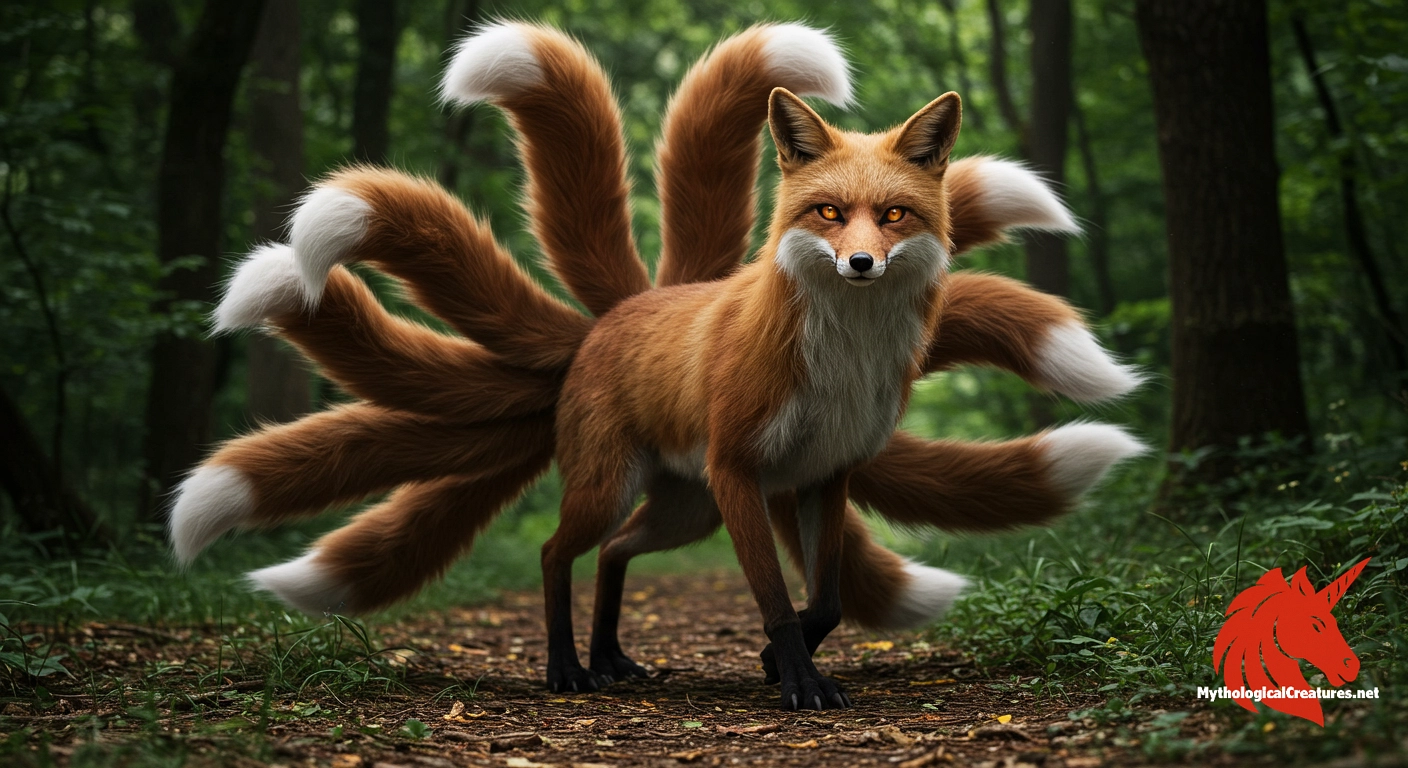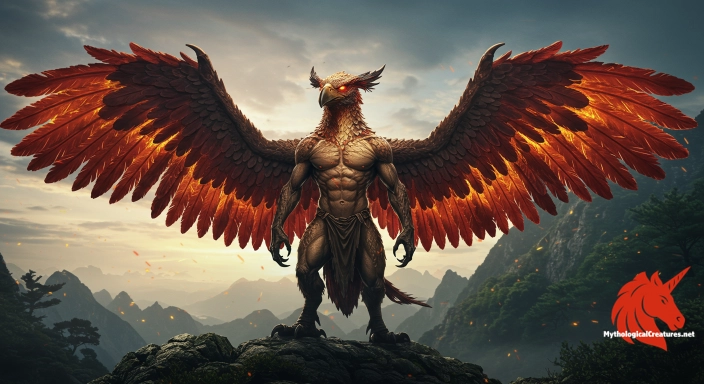Kumiho: The kumiho is a mythical Korean fox spirit famous for its nine tails and ability to transform into a seductive woman.

Kumiho
Kumiho - Represents the peril of deception and the duality of beauty and savagery in folklore
Origins & First Encounters
The legend of the kumiho is woven deeply into Korea’s rich tapestry of folklore, boasting a history that stretches back centuries. This enigmatic creature, often depicted with nine luxurious tails, has been an essential part of East Asian mythological tradition from early oral narratives to later literary compilations. Emerging from a cultural milieu imbued with mystery and cautionary wisdom, the kumiho originally symbolised the blurred line between beauty and danger. Its earliest attestations in Korean folklore reveal a being both seductive and formidable in its predatory nature. The kumiho’s dual identity as a graceful beauty capable of transforming into a lethal force has fascinated storytellers and audiences alike. As folklore evolved, so too did the creature’s symbolism, reflecting societal fears about the untamed aspects of desire and nature. The myth encapsulates themes of transformation, allure, and inevitable retribution, making it a timeless character in Korea’s mythic narratives. Its continued popularity testifies to the enduring power of these folktales and the universal allure of a creature that embodies both charm and peril.
Source Texts & Tale Variants
The primary accounts of the kumiho are rooted in the compendium of Korean oral literature where numerous versions of its tale have been passed down through generations. Early literature and collected folktales present the kumiho as a creature whose origin story is shrouded in mystery and multiple interpretations. Textual references and folkloric compilations often provide vivid narratives that range from cautionary tales to elaborate mythic adventures. Various manuscripts and traditional storytellings offer different accounts, some emphasising the creature’s malevolent thirst for human organs and others portraying a more nuanced, transformative quest for humanity. The diversity of these sources not only underscores the complexity of the kumiho myth but also highlights regional storytellers’ adaptations over time. Some sources meticulously note the creature’s uncanny ability to manipulate perceptions by shifting between human and animal forms. Oral transmissions preserved through festivals and local recitations add further layers to its mythos. The wealth of literary and folkloric material ensures that the kumiho continues to be a subject of intrigue and scholarly reflection within the realm of mythological studies.
Form & Powers
The kumiho is most recognisable for its striking nine tails, each imbued with an aura of magical potency and mystery. In its natural fox form, it is depicted with a sleek, lustrous coat that ranges from deep russet to a shimmering silver under moonlight. Every tail is said to flicker with an almost sentient energy, symbolising its accumulated power over time. When it transforms, the kumiho takes on the appearance of a beguiling, graceful woman with captivating eyes that hint at both wisdom and danger. Some depictions maintain subtle traces of its animal origin, such as slightly pointed ears or an ever-so-slight gleam in its eyes. The transformation is so complete that often only the unusual charm or a mysterious air remains as a clue to her true nature. Variations in size and physical attributes exist, with some legends suggesting that its form grows increasingly majestic as it accrues more tails. Overall, the creature’s portrayal combines both the elegance of human form and the untamed allure of the wild, creating a memorable fusion of beauty and ferocity.
Regional Faces
Within Korea, the kumiho occupies a unique niche that sets it apart from similar fox spirits in neighbouring cultures. Local adaptations often infuse the creature with qualities that mirror the societal values and cautionary messages of various regions. In some rural areas, the kumiho is depicted not merely as a predator but as a tragic figure caught between two natures. Such narratives sometimes suggest that the beast’s fate could change if it transcends its inherent malicious impulses. While the core myth centres on seduction and the consumption of human organs, some regional variants introduce elements of sorrow and longing, giving the creature a more multifaceted persona. Unlike the often benevolent fox spirits found in Japanese folklore, the Korean kumiho retains a decidedly dangerous edge in local tales. Specific areas have even woven rituals and warnings into daily life, using the myth as a deterrent against immoral behaviour. These regional retellings ensure that the kumiho remains a dynamic symbol, continuously evolving to reflect the changing cultural landscapes of Korea.
Cultural Parallels
The kumiho shares intriguing parallels with its East Asian counterparts, such as the Japanese kitsune and the Chinese jiuweihu, yet maintains distinctive characteristics that set it apart. While the Japanese kitsune is celebrated for its intelligence and multifaceted roles ranging from trickster to guardian, the kumiho is more consistently depicted as a perilous seductress. In Chinese lore, the nine-tailed fox also appears as a shape-shifter, however, its role oscillates more markedly between benevolence and malice depending on the region and period. The Vietnamese hồ ly tinh similarly presents a complex blend of beauty and danger, drawing lines of comparison with the kumiho’s narrative. These cultural comparisons illustrate how the motif of a transformative, foxlike creature serves as a versatile allegory across traditions. Each version reflects the societal values and aesthetic preferences of its culture, linking beauty with treachery in compelling ways. The cross-cultural connections emphasise a shared fascination with creatures that can embody both allure and ultimate ruin. This comparative analysis not only enriches the understanding of the kumiho but also spotlights the broader symbology of shape-shifting fox spirits in East Asian mythologies.
Legacy & Modern Evolution
Over the centuries, the image of the kumiho has undergone significant transformation, shifting from a purely fearsome demon into a more layered and occasionally sympathetic character. Its depiction in early folktales was stark, often serving as a grim warning about the dangers of seduction and the unpredictability of nature. In modern times, the kumiho has been reimagined in films, television dramas, and literature, frequently portrayed with a complexity that reflects contemporary concerns about identity and morality. These modern reinterpretations often explore the creature’s internal conflict, blurring the lines between victim and villain. New narratives incorporate elements of redemption, offering a more nuanced perspective that challenges the simplistic portrayals of old. The kumiho now frequently represents the struggle between primal instincts and the desire for human connection, a theme that resonates strongly with today’s audiences. Its legacy is continually reshaped by artistic expression and cultural dialogue, ensuring that this mythological figure remains relevant. The enduring allure of the kumiho lies in its ability to symbolise transformation and the eternal conflict between beauty and brutality, a narrative that adapts gracefully to the evolving ethos of modern society.
Interesting Fact
Unlike its Japanese counterpart the kitsune, which can be benevolent, the kumiho is predominantly depicted as a malevolent entity, reflecting unique cultural attitudes towards fox spirits in Korea.
Quick Creature Info
Origin:
Features:
Associations:
Our Mythic Legendary Rating:

Also Sometimes Known As:
Habitat:
Supernatural Powers:
Physical Attributes:
Abilities:
Behavior:
Weaknesses:
Lore:
Related Creatures, Tales or Lore
- jjiuweihu
- kkitsune
- hhồ ly tinh
References
Discover Another Mythical Legend You May Not Have Heard Of?
Uncover the mysteries of ancient folklore and expand your knowledge of legendary beings from cultures around the world.
Dare to Meet the Karura....
Mythical Disclaimer: The images and data on this site are derived from various historical and literary sources, but we have found that many myths often have multiple versions and interpretations across references, sometimes contradictory. As a result, these creature depictions are artistic interpretations—imaginative blends of folklore, legend, and a dash of AI guesswork. Because creature descriptions vary widely, our illustrations and accompanying information represent our best effort to honor mythology while bridging creative gaps. Enjoy these interpretations—just remember, we've done our best to respect the stories and validate available data, but in the realm of mythology, details often shift, imagination leads the way, and nothing is ever set in stone!
Curated by the Mythological Creatures Team (rev. May 2025)
